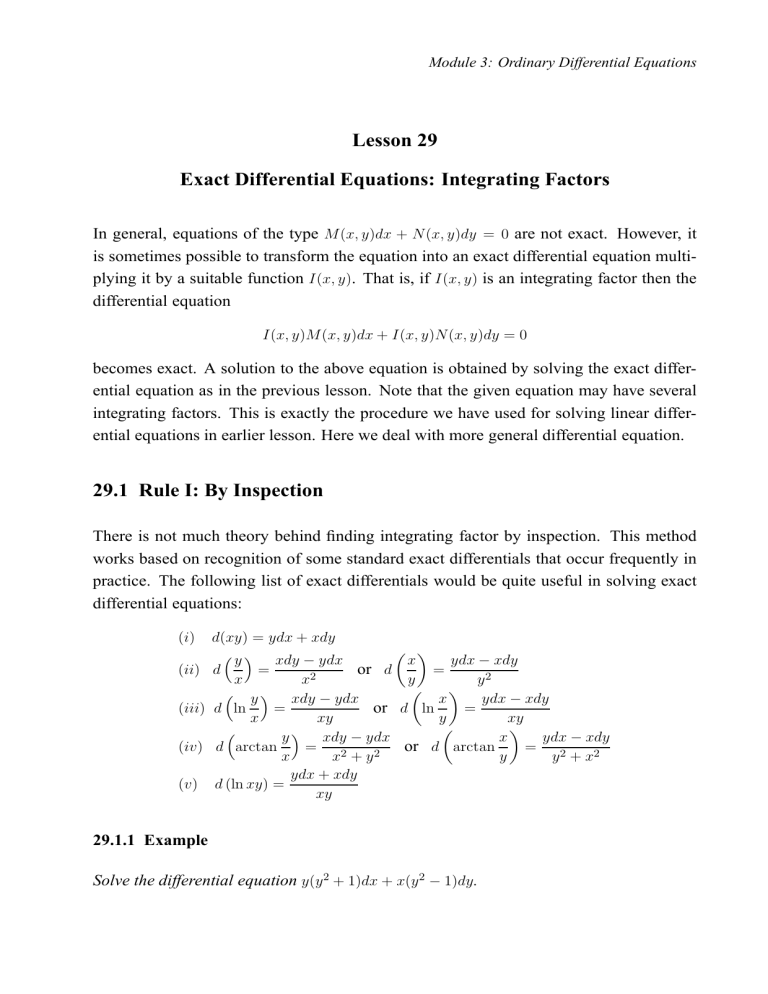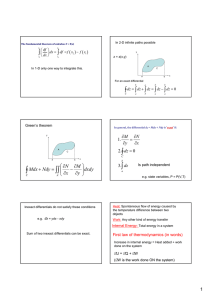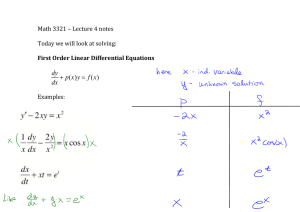
Module 3: Ordinary Differential Equations Lesson 29 Exact Differential Equations: Integrating Factors In general, equations of the type M(x, y)dx + N(x, y)dy = 0 are not exact. However, it is sometimes possible to transform the equation into an exact differential equation multiplying it by a suitable function I(x, y). That is, if I(x, y) is an integrating factor then the differential equation I(x, y)M(x, y)dx + I(x, y)N(x, y)dy = 0 becomes exact. A solution to the above equation is obtained by solving the exact differential equation as in the previous lesson. Note that the given equation may have several integrating factors. This is exactly the procedure we have used for solving linear differential equations in earlier lesson. Here we deal with more general differential equation. 29.1 Rule I: By Inspection There is not much theory behind finding integrating factor by inspection. This method works based on recognition of some standard exact differentials that occur frequently in practice. The following list of exact differentials would be quite useful in solving exact differential equations: (i) (ii) (iii) (iv) (v) d(xy) = ydx + xdy y xdy − ydx ydx − xdy x = = or d d x x2 y y2 y xdy − ydx ydx − xdy x d ln = = or d ln x xy y xy xdy − ydx ydx − xdy x y = = or d arctan d arctan 2 2 x x +y y y 2 + x2 ydx + xdy d (ln xy) = xy 29.1.1 Example Solve the differential equation y(y 2 + 1)dx + x(y 2 − 1)dy . Exact Differential Equations: Integrating Factors Solution: The given equation can be rewritten as y 2(ydx + xdy) + ydx − xdy This is further rewritten as (ydx + xdy) + ydx − xdy y2 =0 Using standard differential forms given above we get x d(xy) + d =0 y Integrating the above equation, the desired solution is given as xy 2 + x = cy Here c is an arbitrary constant. 29.2 Rule II: Mdx + N dy = 0 is homogeneous and Mx + N y 6= 0 If the equation Mdx+Ndy = 0 is homogeneous and Mx+Ny 6= 0, then I(x, y) = 1 (Mx + Ny) is an integrating factor. In order to prove the result, we need to show that Mdx + Ndy = d (some function x and y) Mx + Ny Rewriting Mdx + Ndy as 1 Mdx + Ndy = 2 (Mx + Ny) dx dy + x y + (Mx − Ny) dx dy − x y Multiplying by proposed integrating factor we get Mdx + Ndy 1 = Mx + Ny 2 dx dy + x y (Mx − Ny) + (Mx + Ny) dx dy − x y (29.1) Given that M(x, y) and N(x, y) are homogeneous functions of some degree n, i.e., M(tx, ty) = tn M(x, y) and N(x, y) = tn N(x, y). Then M x ,1 y =M 1 1 x, y y y 1 = n M(x, y) ⇒ M(x, y) = y n M y 2 x ,1 y Exact Differential Equations: Integrating Factors Similarly, we get n N(x, y) = y N x ,1 y Now consider y nxM x y,1 y nyN x y,1 − (Mx − Ny) = = x x (Mx + Ny) n n y xM y , 1 + y yN y , 1 x yM x y,1 −N x y,1 x =f x x x y yM y,1 + N y,1 Going back to the Equation (29.1), we have Mdx + Ndy 1 = Mx + Ny 2 x x d (ln(xy)) + f d ln y y Rewriting f (x/y) = f (exp(ln(x/y))) and defining g(x) := f (exp(x)), the above equation becomes 1 Mdx + Ndy = Mx + Ny 2 x d (ln(xy)) + g (ln(x/y)) d ln y Hence, we have shown that Z Mdx + Ndy x x 1 1 g ln d ln =d ln(xy) + Mx + Ny 2 2 y y 1 is an integrating factor of the homogenous differential equation Mdx + Mx + Ny Ndy = 0. Thus 29.2.1 Example Solve the differential equation (x2 y − 2xy 2 )dx − (x3 − 3x2 y)dy = 0 Solution: The given equation is a homogeneous differential equation. Comparing it with Mdx + Ndy = 0, we have M = x2 y − 2xy 2 and N = −(x3 − 3x2 y). Since Mx + Ny = (x2 y − 2xy 2 )x − y(x3 − 3x2 y) = x2 y 2 6= 0, the integrating factor is 1 1 = 2 2 (Mx + Ny) x y Multiply by the integrating factor, the given differential equation becomes (1/y − 2/x)dx − (x/y 2 − 3/y)dy = 0 3 Exact Differential Equations: Integrating Factors This is now exact and can be rewritten as ydx − xdy 2 3 − dx + dy = 0 y2 x y 2 x 3 − dx + dy = 0 d y x y ⇒ Integrating the above equation we obtain the desired solution as x − 2y ln x + 3y ln y = cy 29.3 Rule III: Mdx + N dy = 0 is of the form f1(xy)ydx + f2(xy)xdy = 0 If the equation Mdx + Ndy = 0 is of the form f1 (xy)ydx + f2(xy)xdy = 0, then 1 (Mx − Ny) is an integrating factor provided Mx − Ny 6= 0. Similar to rule II we now show that Mdx + Ndy = d (some function x and y) Mx − Ny Again, rewriting Mdx + Ndy as 1 Mdx + Ndy = 2 (Mx + Ny) dx dy + x y + (Mx − Ny) dx dy − x y Now dividing by Mx − Ny we get Mdx + Ndy 1 = Mx − Ny 2 (Mx + Ny) Mx − Ny dx dy + x y + dx dy − x y Using M = f1 (xy)y and N = f2 (xy)x we obtain Mdx + Ndy 1 = Mx − Ny 2 f1 (xy) + f2 (xy) x d (ln xy) + d ln f1 (xy) − f2 (xy) y f1 (xy) + f2 (xy) and g(x) := f (exp(x)), the above equation reduces to f1 (xy) − f2 (xy) x 1 x 1 Mdx + Ndy f (xy)d (ln xy) + d ln = g(ln xy)d (ln xy) + d ln = Mx − Ny 2 y 2 y Let f (xy) := This shows that Z 1 x Mdx + Ndy 1 g(ln xy)d (ln xy) + ln =d Mx − Ny 2 2 y 4 Exact Differential Equations: Integrating Factors 29.3.1 Example Solve y(x2 y 2 + 2)dx + x(2 − 2x2 y 2)dy = 0. Solution: Comparing with Mdx+Ndy = 0, we have M = y(x2 y 2 +2) and N = x(2−2x2 y 2 ). The given equation is of the form f1 (xy)ydx + f2 (xy)xdy = 0 and we have Mx − Ny = xy(x2 y 2 + 2) − xy(2 − 2x2 y 2 ) = 3x3 y 3 6= 0 Therefore, multiplying the equation by 1/3x3 y 3 , we obtain (1/3x + 2/(3x3 y 2))dx + (2/(3x2 y 3) − 2/3y)dy = 0 This is an exact differential equation which can be solved with the technique discussed in previous lesson. 29.4 Rule IV: Most general approach Now we discuss the most general approach of finding integrating function. The idea is to multiply the given differential equation M(x, y)dx + N(x, y)dy = 0 (29.2) by a function I(x, y) and then try to choose I(x, y) so that the resulting equation I(x, y)M(x, y)dx + I(x, y)N(x, y)dy = 0 (29.3) becomes exact. The above equation is exact if and only if ∂(IM) ∂(IN) = ∂y ∂x (29.4) If a function I(x, y) satisfying the partial differential Equation (29.4) can be found, then (29.3) will be exact. Unfortunately, solving Equation (29.4), is as difficult to solve as the original Equation (29.2) by some other methods. Therefore, while in principle integrating factors are powerful tools for solving differential equations, in practice they can be found 5 Exact Differential Equations: Integrating Factors only in special cases. The cases we will consider are: (i) an integrating factor I that is either as function of x only, or (ii) a function of y only. Let us determine necessary conditions on M and N so that (29.2) has an integrating factor I that depends on x only. Assuming that I is a function of x only, then Equation (29.4) reduces to IMy = INx + N dI dx ⇒ IMy − INx dI = dx N (29.5) If (My − Nx )/N is a function of x only, say f(x), then there is an integrating factor I R that also depends only on x which can be found by solving (29.5) as I(x) = e f (x)dx . A similar procedure can be used to determine a condition under which Equation (29.2) has an integrating factor depending only on y . To conclude, we have: R ∂N 1 ∂M is function of x alone say f (x), then I(x) = e f (x)dx is an I.F. − If N ∂y ∂x R ∂M 1 ∂N is function of y alone say f (y), then I(y) = e f (y)dy is an I.F. − If M ∂x ∂y 29.5 Example Problems 29.5.1 Problem 1 Find an integrating factor of (x2 + y 2 + x)dx + xydy = 0 Solution: Comparing with Mdx + Ndy = 0, we have M = (x2 + y 2 + x) and N = xy Further, note that 1 N ∂M ∂N − ∂y ∂x = 1 x R is a function of x alone. Hence, the integrating factor of the given problem is e 1/xdx 29.5.2 Problem 2 Find an integrating factor of (2xy 4 ey + 2xy 3 + y)dx + (x2 y 4 ey − x2 y 2 − 3x)dy = 0 Solution: Compare with Mdx + Ndy = 0, we get M = (2xy 4 ey + 2xy 3 + y) and N = (x2 y 4 ey − x2 y 2 − 3x) 6 = x. Exact Differential Equations: Integrating Factors Also, note that 1 M ∂N ∂M − ∂y ∂x =− 4 y R is a function of y alone. Hence the integrating factor of the given problem is e −4/ydy = 1/y 4. Suggested Readings Boyce, W.E. and DiPrima, R.C. (2001). Elementary Differential Equations and Boundary Value Problems. Seventh Edition, John Willey & Sons, Inc., New York. Dubey, R. (2010). Mathematics for Engineers (Volume II). Narosa Publishing House. New Delhi. McQuarrie, D.A. (2009). Mathematical Methods for Scientist and Engineers. First Indian Edition. Viva Books Pvt. Ltd. New Delhi. Raisinghania, M.D. (2005). Ordinary & Partial Differential Equation. Eighth Edition. S. Chand & Company Ltd., New Delhi. Kreyszig, E. (1993). Advanced Engineering Mathematics. Seventh Edition, John Willey & Sons, Inc., New York. Arfken, G.B. (2001). Mathematical Methods for Physicists. Fifth Edition, Harcourt Academic Press, San Diego. Grewal, B.S. (2007). Higher Engineering Mathematics. Fourteenth Edition. Khanna Publishilers, New Delhi. Piskunov, N. (1996). Differential and Integral Calculus (Volume - 2). First Edition. CBS Publisher, Moscow. 7




